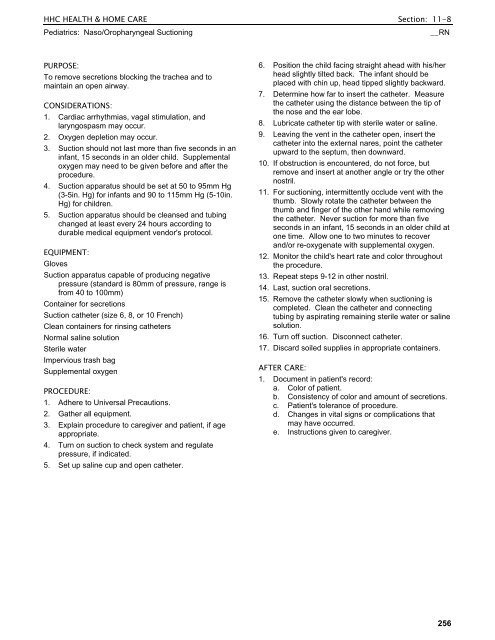HHC Health & Home Care Clinical Policy And
HHC Health & Home Care Clinical Policy And
HHC Health & Home Care Clinical Policy And
You also want an ePaper? Increase the reach of your titles
YUMPU automatically turns print PDFs into web optimized ePapers that Google loves.
<strong>HHC</strong> HEALTH & HOME CARE Section: 11-8<br />
Pediatrics: Naso/Oropharyngeal Suctioning __RN<br />
PURPOSE:<br />
To remove secretions blocking the trachea and to<br />
maintain an open airway.<br />
CONSIDERATIONS:<br />
1. Cardiac arrhythmias, vagal stimulation, and<br />
laryngospasm may occur.<br />
2. Oxygen depletion may occur.<br />
3. Suction should not last more than five seconds in an<br />
infant, 15 seconds in an older child. Supplemental<br />
oxygen may need to be given before and after the<br />
procedure.<br />
4. Suction apparatus should be set at 50 to 95mm Hg<br />
(3-5in. Hg) for infants and 90 to 115mm Hg (5-10in.<br />
Hg) for children.<br />
5. Suction apparatus should be cleansed and tubing<br />
changed at least every 24 hours according to<br />
durable medical equipment vendor's protocol.<br />
EQUIPMENT:<br />
Gloves<br />
Suction apparatus capable of producing negative<br />
pressure (standard is 80mm of pressure, range is<br />
from 40 to 100mm)<br />
Container for secretions<br />
Suction catheter (size 6, 8, or 10 French)<br />
Clean containers for rinsing catheters<br />
Normal saline solution<br />
Sterile water<br />
Impervious trash bag<br />
Supplemental oxygen<br />
PROCEDURE:<br />
1. Adhere to Universal Precautions.<br />
2. Gather all equipment.<br />
3. Explain procedure to caregiver and patient, if age<br />
appropriate.<br />
4. Turn on suction to check system and regulate<br />
pressure, if indicated.<br />
5. Set up saline cup and open catheter.<br />
6. Position the child facing straight ahead with his/her<br />
head slightly tilted back. The infant should be<br />
placed with chin up, head tipped slightly backward.<br />
7. Determine how far to insert the catheter. Measure<br />
the catheter using the distance between the tip of<br />
the nose and the ear lobe.<br />
8. Lubricate catheter tip with sterile water or saline.<br />
9. Leaving the vent in the catheter open, insert the<br />
catheter into the external nares, point the catheter<br />
upward to the septum, then downward.<br />
10. If obstruction is encountered, do not force, but<br />
remove and insert at another angle or try the other<br />
nostril.<br />
11. For suctioning, intermittently occlude vent with the<br />
thumb. Slowly rotate the catheter between the<br />
thumb and finger of the other hand while removing<br />
the catheter. Never suction for more than five<br />
seconds in an infant, 15 seconds in an older child at<br />
one time. Allow one to two minutes to recover<br />
and/or re-oxygenate with supplemental oxygen.<br />
12. Monitor the child's heart rate and color throughout<br />
the procedure.<br />
13. Repeat steps 9-12 in other nostril.<br />
14. Last, suction oral secretions.<br />
15. Remove the catheter slowly when suctioning is<br />
completed. Clean the catheter and connecting<br />
tubing by aspirating remaining sterile water or saline<br />
solution.<br />
16. Turn off suction. Disconnect catheter.<br />
17. Discard soiled supplies in appropriate containers.<br />
AFTER CARE:<br />
1. Document in patient's record:<br />
a. Color of patient.<br />
b. Consistency of color and amount of secretions.<br />
c. Patient's tolerance of procedure.<br />
d. Changes in vital signs or complications that<br />
may have occurred.<br />
e. Instructions given to caregiver.<br />
256







